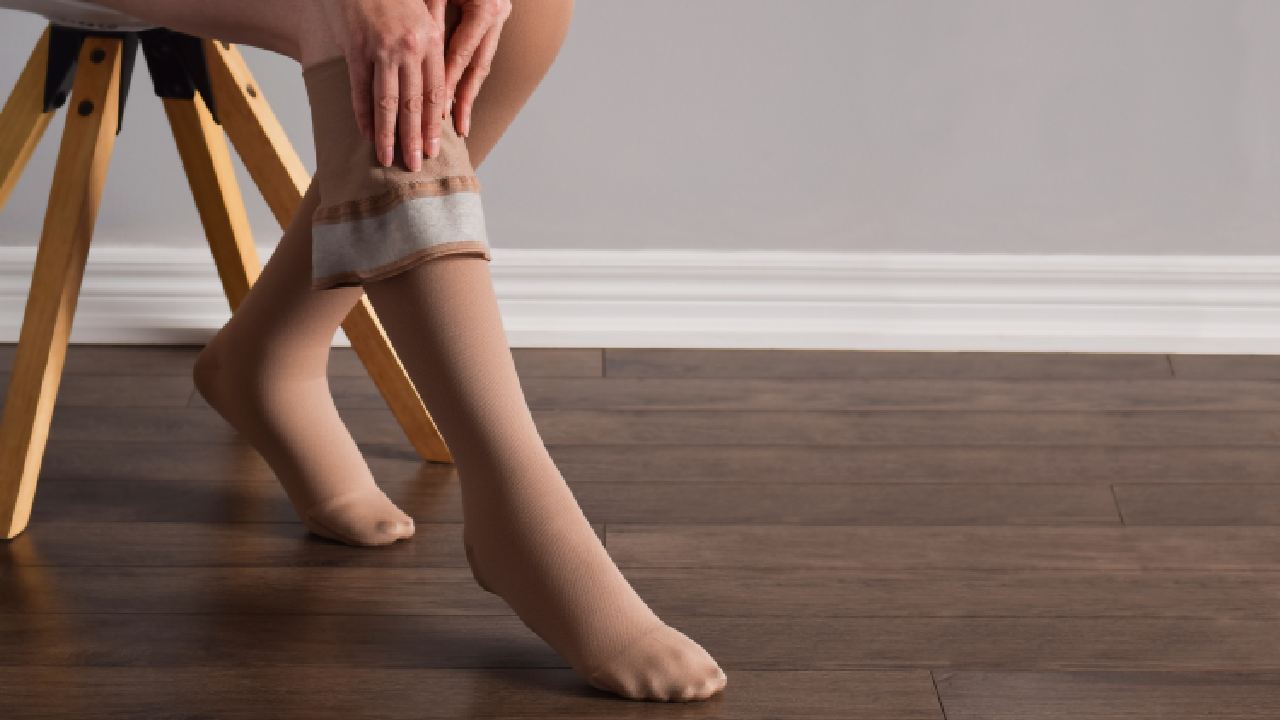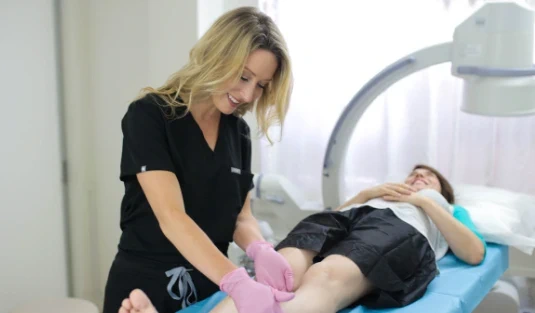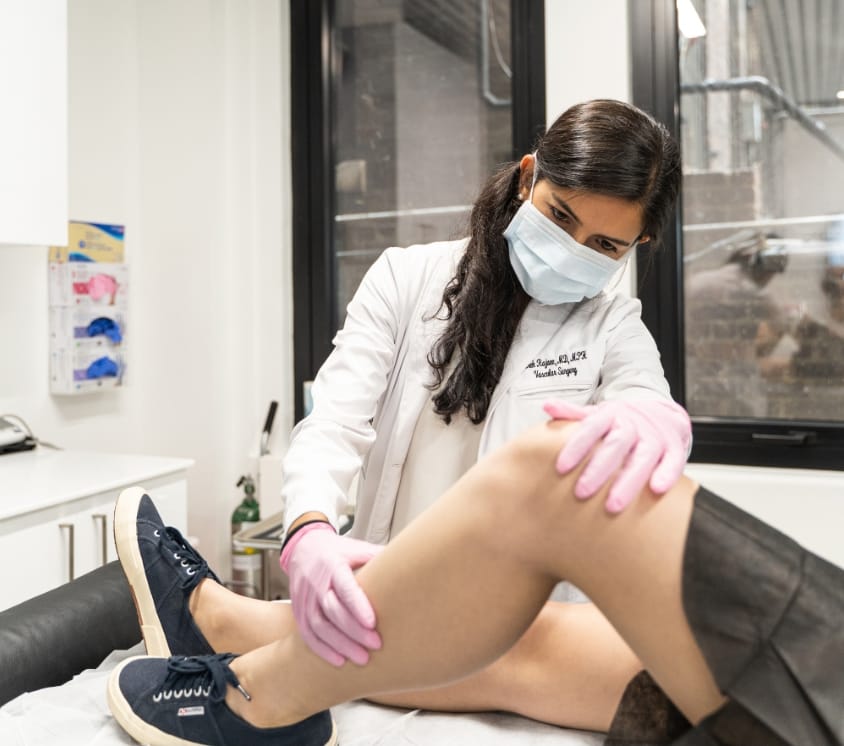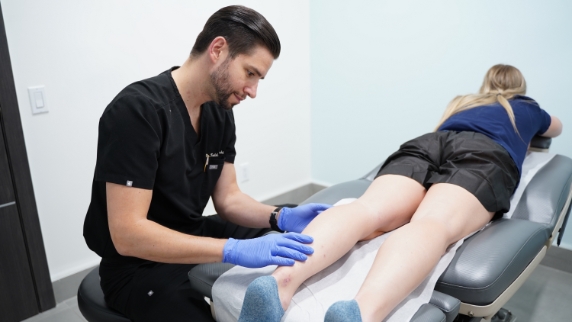If you’ve been struggling with varicose veins, you’re not alone. You may have noticed that your legs feel heavy, achy, or swollen, especially after standing or sitting for long periods. These are not only frustrating but can also be a sign of poor circulation and underlying venous issues. One remedy many people turn to is compression stockings for varicose veins, a non-invasive solution that can provide relief and improve circulation. But do they really work?
At Vein Treatment Clinic, we understand the impact that varicose veins can have on your life, and we’re here to help you navigate the best treatment options. While compression stockings can be useful in managing symptoms, they don’t address the root cause of varicose veins. In this article, we’ll explore how compression stockings work, their benefits, their limitations, and what you can do for a permanent solution.
What are Compression Stockings?
Compression stockings are specially designed hosiery that gently squeeze your legs, ankles, and feet to improve blood flow. They apply graduated pressure, meaning they are tighter at the ankle and gradually loosen as they move up the leg. This pressure helps the veins in your legs return blood to your heart more efficiently, reducing swelling, improving circulation, and providing relief from symptoms associated with varicose veins.
There are various types of compression stockings available, ranging from over-the-counter options to custom-made versions that can be prescribed by a vein doctor. These stockings are typically worn throughout the day and are especially beneficial if you spend a lot of time on your feet or if you have jobs that require extended sitting.
How Do Compression Stockings Help with Varicose Veins?
Compression stockings can help manage varicose veins but don’t cure the condition. Below, we’ll explore the key ways these stockings can provide relief.
1. Reduce Swelling
Varicose veins are often associated with swelling, particularly in the lower legs and ankles. This is due to the buildup of blood in the veins, which causes them to expand and stretch. Wearing compression stockings can help reduce swelling. The stockings pressure the legs, encouraging the veins to push blood back toward the heart. This reduces the amount of fluid accumulating in the tissue, helping alleviate puffiness and discomfort.
2. Relieve Leg Pain and Fatigue
One of the most common complaints of people with varicose veins is leg pain, which can feel like heaviness, cramping, or an aching sensation. Compression stockings improve circulation by assisting your veins in pushing blood upward, reducing pressure and strain on the veins. This can reduce leg pain, making it easier to stand or walk without discomfort. Many individuals find that wearing compression stockings during the day helps them avoid fatigue.
3. Prevent Blood Clots
Varicose veins can increase your risk of developing blood clots due to stagnant blood flow in the veins. Compression stockings help promote better circulation, which can reduce the chances of clot formation. By encouraging blood flow upward, the stockings ensure that the blood doesn’t pool in your veins, reducing your risk of deep vein thrombosis (DVT) and other complications.
4. Improve Skin Health
Over time, varicose veins can cause changes in the skin’s appearance, including redness, dryness, and sometimes ulcers. Compression stockings can help keep the skin healthy by improving blood circulation. When blood flows more efficiently, it carries essential nutrients and oxygen to the skin, which can help prevent skin changes and promote healing in areas that have already been affected by varicose veins.
The Limitations of Compression Stockings for Varicose Veins
While compression stockings can provide temporary relief from the symptoms of varicose veins, they are not a cure for the condition itself. Below are some limitations of compression stockings for varicose veins that you should be aware of.
1. They Don’t Treat the Underlying Condition
Compression stockings are effective in managing the symptoms of varicose veins, but they do not address the underlying cause. Varicose veins are typically the result of venous insufficiency, where the veins in the legs have weakened or damaged valves that prevent blood from flowing back to the heart. Compression stockings don’t correct this problem; they only help to alleviate the symptoms caused by poor circulation.
2. Temporary Relief Only
While compression stockings can provide relief from swelling and discomfort, the effects are temporary. You’ll need to wear them regularly to experience the benefits, and once they’re removed, the symptoms may return. Thus, compression stockings are a helpful tool for managing varicose veins in the short term but not a long-term solution.
3. They Can Be Uncomfortable to Wear
Compression stockings apply pressure to the legs, which can be uncomfortable. Some people may find them too tight or difficult to put on, especially if they have limited mobility. Additionally, they may not be suitable for wearing in hot weather, as they can cause your legs to feel warm and sweaty. For some, wearing them consistently can become burdensome over time.
4. They Don’t Prevent Varicose Veins from Getting Worse
Compression stockings won’t stop varicose veins from worsening. If you have venous insufficiency, the condition may continue to progress, leading to more severe symptoms and complications. If you’re concerned about the progression of varicose veins, seeking professional treatment from a board-certified vein doctor or vein treatment clinic is crucial.
How to Remove Spider Veins and Varicose Veins for Good
How to remove spider veins and varicose veins? If you’re looking for a more permanent spider vein treatment or varicose vein treatment, compression stockings are not the answer. The only way to effectively treat varicose veins is through medical intervention, which can include a variety of minimally invasive vein treatments. These vein treatments focus on addressing the underlying cause of venous insufficiency and improving the overall appearance of your legs.
Some of the most common minimally invasive vein treatments include:
- Sclerotherapy: A treatment in which a solution is injected into the veins, causing them to collapse and eventually be absorbed by the body. This is mostly suitable for spider veins.
- Endovenous Laser Ablation (EVLA): A minimally invasive procedure that uses laser energy to close off problematic veins and reroute blood to healthier leg veins.
- Radiofrequency Ablation (RFA): Similar to EVLA, RFA uses radiofrequency energy to treat and close off damaged veins, restoring optimal blood flow to the heart.
- VenaSeal: A procedure that uses a medical adhesive to seal the affected veins.
- ClariVein: A catheter-based treatment that combines mechanical and chemical approaches to close varicose veins.
- Ambulatory Phlebectomy: This is a minimally invasive varicose vein surgery (microsurgery) used to remove larger varicose veins through small incisions.
Visit your nearest vein treatment clinic to learn about the best treatments for you. With state-of-the-art facilities in New York, New Jersey, Long Island, California, and Maryland, Vein Treatment Clinic is dedicated to helping you achieve lasting relief from varicose veins.
Compression stockings can be a useful tool for managing the symptoms of varicose veins, but they don’t offer a permanent solution. If you’re ready to take the next step and explore effective spider vein and varicose vein treatment options, contact us to verify your insurance details, visit your nearest vein treatment clinic, and learn how we can help you regain healthy legs.















